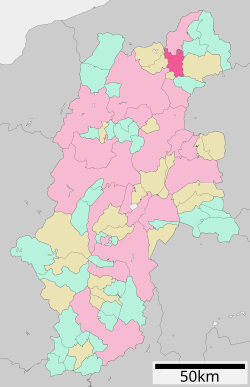Nakano, Nagano
|
Nakano 中野市 |
|||
|---|---|---|---|
| City | |||

Nakano city hall
|
|||
|
|||
 Location of Nakano in Nagano Prefecture |
|||
| Coordinates: 36°44′31.2″N 138°22′9.9″E / 36.742000°N 138.369417°ECoordinates: 36°44′31.2″N 138°22′9.9″E / 36.742000°N 138.369417°E | |||
| Country | Japan | ||
| Region | Chūbu (Kōshin'etsu) | ||
| Prefecture | Nagano | ||
| Area | |||
| • Total | 112.18 km2 (43.31 sq mi) | ||
| Population (October 2016) | |||
| • Total | 43,573 | ||
| • Density | 388/km2 (1,000/sq mi) | ||
| Time zone | Japan Standard Time (UTC+9) | ||
| Symbols | |||
| • Tree | Apple | ||
| • Flower | Paeonia lactiflora | ||
| Phone number | 0269-22-2111 | ||
| Address | 1-3-19 Miyoshi-cho, Nakano-shi, Nagano-ken 383-8614 | ||
| Website | www |
||
Nakano (中野市 Nakano-shi?) is a city located in northernNagano Prefecture, in the Chūbu region of Japan. As of 1 October 2016[update], the city had an estimated population of 43,573 and a population density of 388 persons per km². Its total area was 112.18 square kilometres (43.31 sq mi).
Located in the northern region of Nagano prefecture, the weather in Nakano varies greatly over the seasons. Summers are hot and humid with temperatures often over 30 degrees Celsius, while winters are cold and snowy with temperatures around −10 degrees Celsius. In spring, Nakano is full of cherry and grape blossoms.
The area of present-day Nakano was part of ancient Shinano Province. The area was part of the direct holdings of the Tokugawa shogunate during the Edo period tenryō and was administered from Nakano jin'ya. The modern town of Nakano was established on April 1, 1889 with the establishment of the municipalities system. It was elevated to city status on July 1, 1955 by the merger of the town with neighboring villages of Hino, Entoku, Nagaoka, Hiraoka, Takaoka, Shinano, and Yamato.
On April 1, 2005, the village of Toyota (from Shimominochi District) was merged into Nakano.
The city of Nakano is supported largely by its vast agricultural industry. Nakano boasts high quality fruits and vegetables, including Fuji apples, Kyohō grapes, peaches, pears, rice, asparagus, and mushrooms. The city is also well known for its roses. The biannual rose festival in Ippongi Park displays thousands of rose plants, and attracts tourists from all over Japan. Nakano City has experienced significant growth since the Nagano 1998 Winter Olympics. Located near many popular ski areas, Nakano's economy is augmented by the ski-tourism industry.
...
Wikipedia



